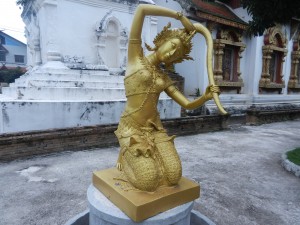Is this beautiful statue a fantasy that monks indulge in as they amble by? I saw sculptures of beautiful women wringing water from their long silky hair in temples all over Thailand, Cambodia and Laos.
This statue actually has deep meanings which take you into some of Southeast Asian cultures’ most ancient roots–one of the world’s most fasinating regions.
The demon Mara tried to jolt Sakyamuni out of his meditation just before he reached enlightenment and became the Buddha. Sakyamuni pointed the the earth with his right hand to invoke his merit, which he earned from offerings in past lives. Dharani, the earth goddess appeared, wrung water from her hair, and flushed Mara and his soldiers away.
This story is especially meaningful in Southeast Asia. Indians’ religious imaginations cooked up thousands of stories. They imagined over 500 past lives that the Buddha had lived, and developed a body of literature about them called the Jatakas. But of all the tales from India, this one has been key in helping many Southeast Asian cultures assimilate Buddhism. Why?
People in Thailand, Cambodia and Laos have lived by and traveled along rivers for more than 2,000 years. The monsoon usaually arrives each year and drenches the steamy land in a burst of grace and power. So flows of water have shaped Southeast Asian cultures’ thinking since ancient times. So the idea of Dharani washing away the dudes with ‘tudes resonated with deep thought patterns.
But Southeast Asians shaped the image of Dharani with their own art forms and made it more graceful. The power in the rivers and monsoons is incontestable. They give life, but they also flood. In both of these pictures of Dharani, the hair and body flow in sinuous S patterns. They seem to magically render nature’s power benevolent.
Thai art and architecture is full of long and flowing curves, including some of the most honored Buddha statues and temples. Thais have used these forms to order their world, as Westerners have used lines and abstract shapes. Each culture’s assumptions about which forms are basic are infinitely rich. And there are more riches in these Thai assumptions.
Now this images DOES look like a male fantasy–it’s got mine flowing. It’s in an obscure wat in Luang Prabang, Laos. The artist was there (I didn’t post that pic because I’d rather not obstruct the view:-)), and there was a strong fresh paint smell in the air. So these statues are a living tradition.
Though Thai, Laotian and Cambodian Buddhist art is made with a lot of decorum, it’s also pretty. People are able to enjoy the beauty of the world. The universe hangs together through grace and tolerance. The sinuous art forms express the Buddha’s compassion, the world’s beauty, and the gentle side of nature’s power. They harmonize all things, so they unify the world.
They instil piety, but they also allow fun. Categories of experience aren’t defined too sharply–they gently mesh and flow like a river.





Comments on this entry are closed.